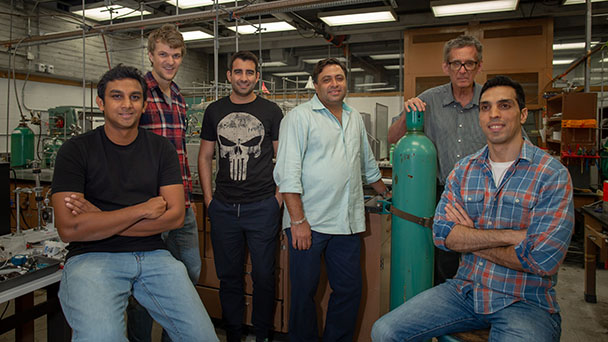For his discovery that propelled the mass production of explosives and poison gas, killing millions of people in two world wars, Fritz Haber is often called “the father of chemical warfare.” But the process the German chemist invented to synthesize ammonia out of thin air also gave rise to a commercial product that continues to save millions more people around the globe from starvation: fertilizer.
A century after Haber was awarded the 1918 Nobel Prize in Chemistry for “fixing” or converting atmospheric nitrogen from a gas into ammonium nitrate, the most common agriculture fertilizer in use today, two University of Miami chemists hope to modify a step in the Haber process with a more efficient and environmentally friendly method that could revolutionize the production of fertilizer.
“I’m from Missouri, the show-me state, and we haven’t shown a lot yet, but if this thing works, it will be a very big deal,” said Carl Hoff, professor of chemistry in the College of Arts and Sciences. “Right now, the fertilizer industry spends a lot of money and energy to get rid of nitrous oxide, a toxic waste byproduct of fertilizer production. What we’re trying to do is take the waste and convert it to more fertilizer, which will save a lot of money and energy and ultimately contribute to a cleaner environment.”
Hoff and Burjor Captain, associate professor of chemistry, were recently awarded a $425,000 grant from the U.S. Department of Energy’s Office of Basic Energy Sciences to test their idea for cleaning up the production of fertilizer. With graduate students Jack Davis, Mohan Gamage, Leonardo Serafim, and Musa Ahmadi, they are trying to create a new chemical reaction that will convert nitrous oxides into nitric acid, the basic raw material used in fertilizer production.

Their goal is to develop a cleaner alternative to the Ostwald process, which in tandem with the Haber process, manufacturers have relied on for decades to produce the fertilizer needed to feed half of the world’s population. They use the Haber process to synthesize ammonia, the requisite raw material for both fertilizers and explosives, from hydrogen and nitrogen. Then they employ the Ostwald process which, patented by fellow German chemist Wilhelm Ostwald, neutralizes ammonia to make nitric acid, the main raw material for the most common type of fertilizer.
But as Hoff and Captain note, the high-temperature, high-pressure Ostwald process is wasteful and dirty. It produces nitric acid by burning half the ammonia produced in the Haber process, usually with coal, and leaves behind nitrous oxide, the toxic byproduct commonly known as laughing gas.
“Laughing gas is no laughing matter. People make a big deal about carbon dioxide and methane, but nitrous oxide is the pollutant of the future,” Captain said. “It is 300 times as bad as carbon dioxide and when you produce fertilizer you produce nitrous oxide and spend a lot of money and energy to decompose it. The question is: can we clean up the nitrous oxide and convert it to nitric acid?”
In theory, the answer is yes. Now Hoff’s and Captain’s labs are trying to put the theory into practice by developing a metal catalyst capable of producing nitrates directly from the nitrogen in nitrous oxide. The painstaking process involves making new compounds and testing how they react with nitrous oxide.
If they succeed, they will do something akin to what bacteria in the roots of certain plants do naturally, which is to “fix” or catch nitrogen gas from the air to produce ammonia, the building blocks for proteins in animal muscle tissue.
But plants can’t produce ammonia on a large, industrial scale, and neither could humans until 1913, after Haber developed the process for using a transition metal catalyst, iron, under high temperatures and pressures to convert atmospheric nitrogen to ammonia by a reaction with hyrogen. His discovery, which provided Germany a desperately needed source of ammonia for the production of explosives, is credited with prolonging World War I by four years. At the time, Germany was running out of gun powder and, due to a British naval blockade that cut off the supply of nitrates, was facing almost instant defeat.
Today, a century after Haber won the Nobel prize in chemistry for, in essence, mimicking Mother Nature and enabling the mass production of agricultural fertilizers, chemists like Hoff are largely giving up on improving his process, and focusing on the Ostwald process instead.
“People have tried for 100 years now to improve on what Haber discovered at the onset of World War I,” Hoff said. “But, just like the automobile, a lot of improvements have been made, but at its core, the Haber process is basically the same. Haber may be reviled for creating weapons that killed millions, but without his contribution to the artificial production of fertilizer, the world would be facing mass starvation.”

